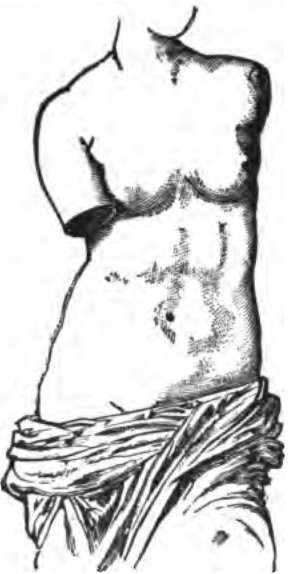The Respiratory Sounds
Description
This section is from the book "The Human Body: An Elementary Text-Book Of Anatomy, Physiology, And Hygiene", by H. Newell Martin. Also available from Amazon: The Human Body.
The Respiratory Sounds
The entry and exit of air are accompanied by the respiratory sounds or murmurs, which can be heard on applying the ear to the chest wall. The character of these sounds is different and characteristic over the trachea, the larger bronchial tubes, and portions of lung from which large bronchial tubes are absent. They are variously modified in pulmonary affections, and hence the value of auscultation of the lungs in assisting the physician to form a diagnosis.
Hygienic Remarks
Since the diaphragm when it contracts pushes down the abdominal viscera lying against its under side, these have to make room for themselves by pushing out the soft front of the abdomen, which accordingly protrudes when the diaphragm descends. Hence breathing by the diaphragm is indicated on the exterior by movements of the abdomen, and is often called " abdominal respiration," as distinguished from breathing by the ribs, called "costal" or "chest breathing." In both sexes the diaphragmatic breathing is the more important, but, as a rule, men and children use the ribs less than adult women.
How does expiration differ from it in this respect? Explain how the chest is brought back to its resting position after an inspiration?
Give examples of violent expiration? How does it differ from an ordinary expiration in the forces at work for its production?
What are the respiratory sounds? Where do their characters differ? Why do physicians study them in lung diseases?

Fig. 71. Torso of the Statue known as Venus of Milo.

Fig. 72. Paris Fashion. May. 1880.
Why does the abdomen protrude during an inspiration? What is meant by abdominal respiration? Why? What is costal respiration? Which form of breathing is most developed in women?
Since abdomen and chest alternately expand and contract in healthy breathing, anything which impedes their free movement is to be avoided: the tight lacing which used to be thought elegant, and, indeed, is still indulged in by some who think a distorted form beautiful, seriously impedes one of the most important functions of the body, leading not only to shortness of breath and an incapacity for muscular exertion, but, as has been proved, in many cases to actual disease. In extreme cases of tight lacing some organs are often directly injured, weals of fibrous tissue being, for example, not unfrequently found developed on the liver from the constant pressure of the lower ribs forced against it by a tight corset.
The Lungs, from the congested state of their vessels produced by alcohol, are more subject to the influence of cold, the result being frequent attacks of bronchitis. It has also been recognized of late years that there is a peculiar form of consumption of the lungs which is very rapidly fatal, and found only in alcohol-drinkers.
Why should conditions impeding the movement of chest and abdomen be avoided ? What is the result of tight lacing? What is often found on examining after death the bodies of persons who have practised tight lacing for a long time?
Continue to:
